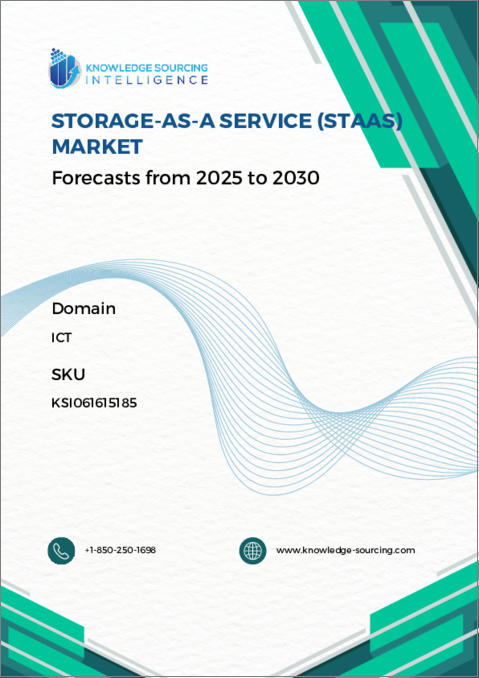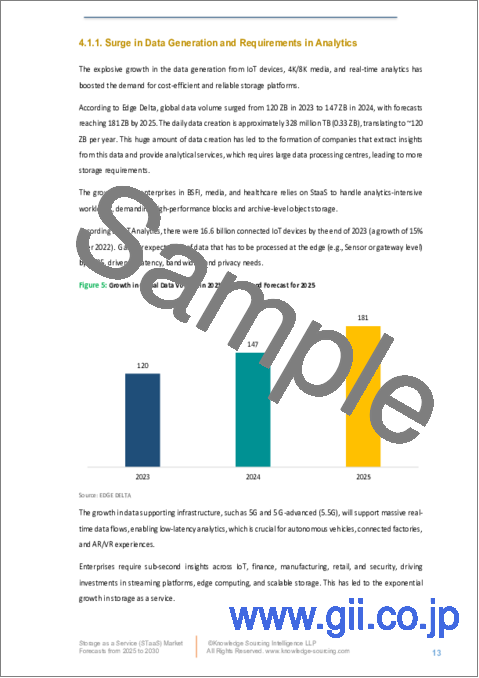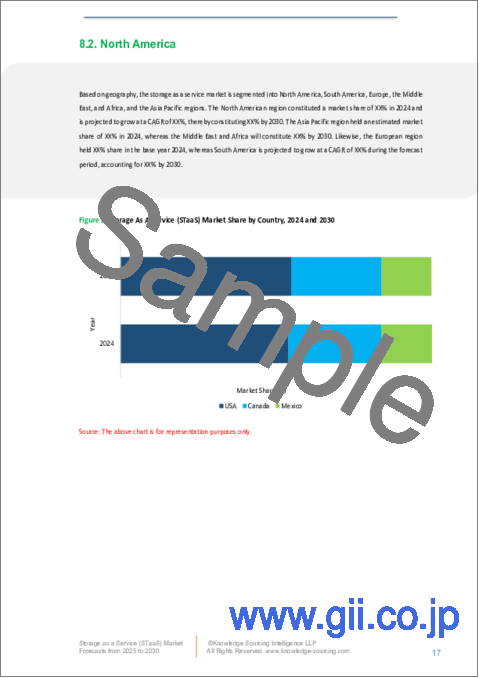|
|
市場調査レポート
商品コード
1495942
StaaS(Storage as a Service)市場:2024年~2029年の予測Storage as a Service (StaaS) Market - Forecasts from 2024 to 2029 |
||||||
カスタマイズ可能
|
|||||||
| StaaS(Storage as a Service)市場:2024年~2029年の予測 |
|
出版日: 2024年05月14日
発行: Knowledge Sourcing Intelligence
ページ情報: 英文 155 Pages
納期: 即日から翌営業日
|
- 全表示
- 概要
- 目次
StaaS(Storage as a Service)市場は、予測期間中にCAGR 32.93%で成長し、2022年の評価額85億5,800万米ドルから2029年には627億7,900万米ドルの市場規模に達すると予測されています。
物理的なストレージ設備の必要性を排除し、インターネット・ネットワークを媒介としたデータへのアクセスやソフトウェア・アプリケーションの効率的なストレージを提供するために、外部の当事者が企業にリモート・ストレージ設備や仕組みを提供することを、STaaS(Storage as a Service)と呼びます。クラウドバックアップ、クラウドアーカイビング、スタンドアロンストレージ、プラットフォームアタッチドストレージが、市場で大企業、中規模企業、小規模企業に利用されているSTaaSサービスの主流でする。
企業はストレージ・インフラに投資して維持する代わりに、サブスクリプション・ベースで必要なストレージの料金を支払うことができるため、コスト効率が高く、柔軟で拡張性のあるストレージ・ソリューションに対するニーズがSTaaSソリューションの需要を促進しています。STaaSが提供する強化されたストレージサービスは、従来のストレージ方式をSTaaSに置き換える結果となっており、STaaS市場の大幅な成長が期待されています。
StaaS(Storage as a Service)市場促進要因
- 企業が生成するデータ量の増加
ビジネスの世界化とデジタル化に伴い、企業が生成するデータ量が急激に増加しているため、オンライン媒体からアクセスできる効果的なストレージ・ソリューションが求められています。Zippiaが実施した調査によると、あらゆる時代を通じて世界で生成される総データの約90%は、過去2年間に生成されたデータに起因すると考えられ、クラウドに保存される企業部門で生成される国際データの量は、2018年の45%から2022年には60%に大きく増加することが明らかになった。
さらに、企業の規制部門によるデータ保持ポリシーの確立により、幅広い年数のデータを定期的に保持する必要性が生じています。例えば、インドの法律で制定された会社法では、企業が作成したデータやアカウントを8年間デジタル保存することが義務付けられています。また、バーゼルIII基準では、所定の業種グループに属する企業は7年間データを保持しなければならないと規定されています。したがって、データ保持の必要性の高まりと、さまざまな業界で事業を展開する企業によって生成されるデータの膨大な増加が、サービスとしてのストレージ・ソリューションとサービスの需要を促進しています。
- クラウドサービスとクラウドコンピューティングの普及
クラウドサービスとクラウドコンピューティング・サービスの採用率の上昇は、簡単な統合によってクラウドインフラを強化・統一するのに役立つため、STaaSサービスの需要をさらに刺激しています。米国のソフトウェア会社Flexeraが作成したレポートによると、2023年には約93%の企業が最低1つのクラウドベースのサービスを利用しており、その平均数は大企業で4.8、中小企業で2.2となっています。
さらに、ITセクターではクラウドインフラへの支出が40%増加し、2022年には58%以上の企業がハイブリッドクラウドネットワークを採用し、2021年から51%増加すると推定されました。また、世界経済フォーラムは、世界中の企業組織の約65%がクラウドコンピューティングを統合するためにビジネスモデルを革新していると述べています。そのため、クラウドコンピューティングとサービスの採用拡大が、予測期間中のSTaaS市場の需要を促進すると予想されます。
StaaS(Storage as a Service)市場の課題:
- 特定のSTaaSサービスに関連するデータポータビリティとセキュリティの制限は、市場の成長を妨げる可能性があります。
特定のプロバイダーやプラットフォームに囲い込まれることで、別のプロバイダーへのデータの移動や転送が複雑になるという懸念から、STaaSソリューションの採用に消極的な企業や事業者もあります。
加えて、STaaSサービスに実装されているセキュリティ対策に関する不確実性は、特にデータプライバシーやセキュリティに関する規制が厳しい業界において、一部の事業会社による機密データや機密データをクラウドに保管するためのSTaaSの利用制限につながっています。しかし、Intelのような大手企業によるSTaaSサービスのセキュリティとコンプライアンス機能の最近の進歩は、この制限を克服することができます。
エンドユーザー別では、BFSI分野がSTaaS市場の開拓に大きく貢献すると予想されます。
BFSI部門で生成されるデータの拡大と、この部門で事業展開する企業におけるデータ主導の意思決定の重要性は、この業界におけるSTaaSやその他のクラウドサービスの需要を促進すると思われます。IBM Corporationによると、銀行業界におけるクラウドの平均導入量は2020年の8.4から2023年には10.9に増加しました。
アジア太平洋地域は、サービスとしてのストレージ市場で大きなシェアを占めており、予測期間中に拡大すると予測されています。
ビッグデータ分析の重要性の高まりや、中国、日本、韓国、台湾などの主要経済圏で事業を展開する企業によるハイブリッドクラウドやマルチクラウドネットワークの採用増加が、同地域のSTaaS市場の成長を促進すると予測されます。
ディザスタリカバリおよび事業継続ソリューションの消費の急増と、企業の成長に牽引されたさまざまなエンドユーザー産業の拡大は、拡大する業務を保存およびアーカイブするための効率的かつコスト効率の高い方法として、STaaSソリューションのニーズを刺激します。
StaaS(Storage as a Service)市場業界の最新情報:
- 2023年10月-Nyriad(R)Inc.は、UltraIOTM-as-a-Serviceのイントロダクションを発表しました。これは、現代企業のデータ管理ニーズの高まりに対応したオンプレミス型STaaS(Storage-as-a-Service)ソリューションの開始を意味します。Nyriadが提供するUltraIO-as-a-Serviceは、柔軟で使いやすいSTaaSオプションを提供することで、さまざまな課題に対応するように設計されています。
- 2023年1月-米国で専門的なサービスとソリューションを提供するIT企業であるイープラスは、Pure Storageのマネージド・サービス・プロバイダー・プログラムにおいて、Pure Storage Evergreen//Oneテクノロジーを利用し、サブスクリプションに基づく適応可能なストレージ・モデルを提供する、新しいサービスとしてのストレージ製品の導入を発表しました。
目次
第1章 イントロダクション
- 市場概要
- 市場の定義
- 調査範囲
- 市場セグメンテーション
- 通貨
- 前提条件
- 基準年と予測年のタイムライン
- ステークホルダーにとっての主なメリット
第2章 調査手法
- 調査デザイン
- 調査プロセス
第3章 エグゼクティブサマリー
- 主な調査結果
第4章 市場力学
- 市場促進要因
- 市場抑制要因
- ポーターのファイブフォース分析
- 業界バリューチェーン分析
- アナリストビュー
第5章 StaaS(Storage as a Service)市場:タイプ別
- イントロダクション
- クラウドバックアップ
- 市場機会と動向
- 成長の見通し
- 地理的な利益性
- クラウドアーカイブ
- 市場機会と動向
- 成長の見通し
- 地理的な利益性
- スタンドアロンおよびプラットフォーム接続ストレージ
- 市場機会と動向
- 成長の見通し
- 地理的な利益性
第6章 StaaS(Storage as a Service)市場:企業規模別
- イントロダクション
- 中小企業
- 市場機会と動向
- 成長の見通し
- 地理的な利益性
- 大企業
- 市場機会と動向
- 成長の見通し
- 地理的な利益性
第7章 StaaS(Storage as a Service)市場:エンドユーザー別
- イントロダクション
- BFSI
- 市場機会と動向
- 成長の見通し
- 地理的な利益性
- ITおよび通信
- 市場機会と動向
- 成長の見通し
- 地理的な利益性
- 小売り
- 市場機会と動向
- 成長の見通し
- 地理的な利益性
- ヘルスケア
- 市場機会と動向
- 成長の見通し
- 地理的な利益性
- 公共部門
- 市場機会と動向
- 成長の見通し
- 地理的な利益性
- 教育
- 市場機会と動向
- 成長の見通し
- 地理的な利益性
- その他
- 市場機会と動向
- 成長の見通し
- 地理的な利益性
第8章 StaaS(Storage as a Service)市場:地域別
- イントロダクション
- 北米
- タイプ別
- 企業規模別
- エンドユーザー別
- 国別
- 南米
- タイプ別
- 企業規模別
- エンドユーザー別
- 国別
- 欧州
- タイプ別
- 企業規模別
- エンドユーザー別
- 国別
- 中東・アフリカ
- タイプ別
- 企業規模別
- エンドユーザー別
- 国別
- アジア太平洋地域
- タイプ別
- 企業規模別
- エンドユーザー別
- 国別
第9章 競合環境と分析
- 主要企業と戦略分析
- 市場シェア分析
- 合併、買収、合意およびコラボレーション
- 競合ダッシュボード
第10章 企業プロファイル
- Intel Corporation
- Google LLC
- Microsoft
- AWS Solutions Group
- IBM
- AT&T
- Oracle
- Rackspace
- Hitachi Vantara LLC
- Hewlett Packard Enterprise Development LP
The storage as a service (STaaS) market is expected to grow at a CAGR of 32.93% over the forecast period to reach a market size of US$62.779 billion by 2029 from a valuation of US$8.558 billion in 2022.
The provision of a remote storage facility and structure to companies by an external party to give access to data and efficient storage of software applications through the medium of an internet network by eliminating the need for physical storage facilities is referred to as storage as a service (STaaS). Cloud backup, cloud archiving, and standalone and platform-attached storage are the dominant types of STaaS services being consumed by large, medium, and small-scale enterprises in the market.
The need for cost-effective, flexible, and scalable storage solutions is driving the demand for STaaS solutions since enterprises can pay for the storage, they need on a subscription basis instead of investing and maintaining their storage infrastructure. The enhanced storage service offered by STaaS is resulting in the substitution of conventional storage methods with STaaS which is expected to result in the substantial growth of the STaaS market.
Storage as a service (staas) market drivers:
- Rise in the volume of data generated by companies
The exponential growth in the amount of data generated by companies fueled by the globalization and digitalization of business operations is resulting in the need for effective storage solutions that can be accessed by the company through online mediums. A survey conducted by Zippia revealed that approximately 90% of the aggregate data generated by the world through all times can be attributed to the data generated in the previous two years and that the amount of international data generated by the corporate sector that is stored in cloud majorly increased from 45% in 2018 to 60% in 2022.
In addition, the establishment of data retention policies by corporate regulatory departments is generating the need for periodic retention of data for a wide range of years. For instance, the Companies Act created by the Indian legislation requires companies to digitally store the data and accounts generated by companies for 8 years. In addition, the Basel III standards specify that companies belonging to the prescribed group of industries must retain their data for 7 years. Therefore, the growing need for data retention and the voluminous growth in the data generated by companies operating in different industries is driving the demand for storage as service solutions and services.
- Extensive adoption of cloud services and cloud computing
The rise in the adoption rates of cloud services and cloud computing services is further stimulating the demand for STaaS services as it aids in fortifying and unifying the cloud infrastructure by easy integration. A report generated by Flexera, a software company in the US revealed that approximately 93% of the companies are utilizing a minimum of one service based on cloud in 2023 with the average number varying from 4.8 in enterprises of large size and 2.2 among SMEs.
In addition, it was also estimated that the cloud infrastructure spending increased by 40% in the IT sector resulting in the adoption of hybrid cloud networks by more than 58% of the companies in 2022 increasing by 51% from 2021. The World Economic Forum also stated that approximately 65% of corporate organizations around the world are innovating their business model to integrate cloud computing. Therefore, the growth in the adoption of cloud computing and services is expected to drive the demand for the STaaS market over the forecast period.
Storage as a service (staas) market challenges:
- The data portability and security limitations associated with certain STaaS services can hinder market growth.
Certain companies and enterprises are reluctant the adopt of STaaS solutions due to their concerns over being locked into a specific provider or platform which leads to complications in moving and transmitting their data to a different provider which could be particularly challenging if the data is stored in a proprietary format that is not easily compatible with other platforms or systems.
In addition, the uncertainties about the security measures implemented into STaaS services are leading to the restricted use of STaaS to store sensitive or confidential data in the cloud by some operating enterprises, particularly in industries with strict data privacy and security regulations. However, the recent advancements in security and compliance features of STaaS services by major companies such as Intel can overcome this limitation.
By end-users, the BFSI sector is anticipated to contribute significantly to the development of the STaaS market.
The expansion of data generated by the BFSI sector and the importance of data-driven decision-making in companies operating in this sector will promote the demand for STaaS and other cloud services in this industry. The average amount of cloud deployment in the banking industry increased from 8.4 in 2020 to 10.9 in 2023 according to the IBM Corporation.
Asia Pacific region holds a significant share of the storage as a service market and is projected to expand during the forecasted period.
The rise in the importance of big data analytics and the increase in the adoption of hybrid and multi-cloud networks by companies operating in major economies such as China, Japan, South Korea, and Taiwan are expected to promote the growth of the STaaS market in the region.
The surge in consumption of disaster recovery and business continuity solutions and the expansion of the various end-user industries driven by the growth of companies will stimulate the need for STaaS solutions as an efficient and cost-effective method to store and archive the expanding business operations.
Storage as a service (staas) market Industry Updates:
- October 2023- Nyriad(R) Inc., unveiled the introduction of UltraIOTM-as-a-Service. This marked the inception of an on-premise Storage-as-a-Service (STaaS) solution tailored to meet modern enterprises' escalating data management needs. Nyriad's UltraIO-as-a-Service offering was crafted to address various challenges by offering flexible and easy-to-use STaaS options.
- January 2023- ePlus Inc., an IT company operating in the US to provide specialized services and solutions announced the introduction of new storage as a service product under its Pure Storage's Managed Services Provider Program by using its Pure Storage Evergreen//One technology to offer adaptable storage models based on subscriptions.
Storage As A Service (STaaS) Market is segmented and analyzed as below:
By Type
- Cloud Backup
- Cloud Archiving
- Standalone and Platform Attached Storage
By Enterprise Size
- SME
- Large
By End-User
- BFSI
- IT and Telecom
- Retail
- Healthcare
- Public Sector
- Education
- Others
By Geography
- North America
- USA
- Canada
- Mexico
- South America
- Brazil
- Argentina
- Others
- Europe
- Germany
- France
- UK
- Spain
- Others
- Middle East and Africa
- Saudi Arabia
- UAE
- Israel
- Others
- Asia Pacific
- China
- Japan
- India
- South Korea
- Indonesia
- Taiwan
- Others
TABLE OF CONTENTS
1. INTRODUCTION
- 1.1. Market Overview
- 1.2. Market Definition
- 1.3. Scope of the Study
- 1.4. Market Segmentation
- 1.5. Currency
- 1.6. Assumptions
- 1.7. Base, and Forecast Years Timeline
- 1.8. Key benefits to the stakeholder
2. RESEARCH METHODOLOGY
- 2.1. Research Design
- 2.2. Research Process
3. EXECUTIVE SUMMARY
- 3.1. Key Findings
4. MARKET DYNAMICS
- 4.1. Market Drivers
- 4.2. Market Restraints
- 4.3. Porter's Five Forces Analysis
- 4.3.1. Bargaining Power of Suppliers
- 4.3.2. Bargaining Power of Buyers
- 4.3.3. Threat of New Entrants
- 4.3.4. Threat of Substitutes
- 4.3.5. Competitive Rivalry in the Industry
- 4.4. Industry Value Chain Analysis
- 4.5. Analyst View
5. STORAGE AS A SERVICE (STAAS) MARKET BY TYPE
- 5.1. Introduction
- 5.2. Cloud Backup
- 5.2.1. Market opportunities and trends
- 5.2.2. Growth prospects
- 5.2.3. Geographic lucrativeness
- 5.3. Cloud Archiving
- 5.3.1. Market opportunities and trends
- 5.3.2. Growth prospects
- 5.3.3. Geographic lucrativeness
- 5.4. Standalone and Platform Attached Storage
- 5.4.1. Market opportunities and trends
- 5.4.2. Growth prospects
- 5.4.3. Geographic lucrativeness
6. STORAGE AS A SERVICE (STAAS) MARKET BY ENTERPRISE SIZE
- 6.1. Introduction
- 6.2. SME
- 6.2.1. Market opportunities and trends
- 6.2.2. Growth prospects
- 6.2.3. Geographic lucrativeness
- 6.3. Large
- 6.3.1. Market opportunities and trends
- 6.3.2. Growth prospects
- 6.3.3. Geographic lucrativeness
7. STORAGE AS A SERVICE (STAAS) MARKET BY END-USER
- 7.1. Introduction
- 7.2. BFSI
- 7.2.1. Market opportunities and trends
- 7.2.2. Growth prospects
- 7.2.3. Geographic lucrativeness
- 7.3. IT and Telecom
- 7.3.1. Market opportunities and trends
- 7.3.2. Growth prospects
- 7.3.3. Geographic lucrativeness
- 7.4. Retail
- 7.4.1. Market opportunities and trends
- 7.4.2. Growth prospects
- 7.4.3. Geographic lucrativeness
- 7.5. Healthcare
- 7.5.1. Market opportunities and trends
- 7.5.2. Growth prospects
- 7.5.3. Geographic lucrativeness
- 7.6. Public Sector
- 7.6.1. Market opportunities and trends
- 7.6.2. Growth prospects
- 7.6.3. Geographic lucrativeness
- 7.7. Education
- 7.7.1. Market opportunities and trends
- 7.7.2. Growth prospects
- 7.7.3. Geographic lucrativeness
- 7.8. Others
- 7.8.1. Market opportunities and trends
- 7.8.2. Growth prospects
- 7.8.3. Geographic lucrativeness
8. STORAGE AS A SERVICE (STAAS) MARKET BY GEOGRAPHY
- 8.1. Introduction
- 8.2. North America
- 8.2.1. By Type
- 8.2.2. By Enterprise Size
- 8.2.3. By End-User
- 8.2.4. By Country
- 8.2.4.1. United States
- 8.2.4.1.1. Market Trends and Opportunities
- 8.2.4.1.2. Growth Prospects
- 8.2.4.2. Canada
- 8.2.4.2.1. Market Trends and Opportunities
- 8.2.4.2.2. Growth Prospects
- 8.2.4.3. Mexico
- 8.2.4.3.1. Market Trends and Opportunities
- 8.2.4.3.2. Growth Prospects
- 8.2.4.1. United States
- 8.3. South America
- 8.3.1. By Type
- 8.3.2. By Enterprise Size
- 8.3.3. By End-User
- 8.3.4. By Country
- 8.3.4.1. Brazil
- 8.3.4.1.1. Market Trends and Opportunities
- 8.3.4.1.2. Growth Prospects
- 8.3.4.2. Argentina
- 8.3.4.2.1. Market Trends and Opportunities
- 8.3.4.2.2. Growth Prospects
- 8.3.4.3. Others
- 8.3.4.3.1. Market Trends and Opportunities
- 8.3.4.3.2. Growth Prospects
- 8.3.4.1. Brazil
- 8.4. Europe
- 8.4.1. By Type
- 8.4.2. By Enterprise Size
- 8.4.3. By End-User
- 8.4.4. By Country
- 8.4.4.1. Germany
- 8.4.4.1.1. Market Trends and Opportunities
- 8.4.4.1.2. Growth Prospects
- 8.4.4.2. France
- 8.4.4.2.1. Market Trends and Opportunities
- 8.4.4.2.2. Growth Prospects
- 8.4.4.3. UK
- 8.4.4.3.1. Market Trends and Opportunities
- 8.4.4.3.2. Growth Prospects
- 8.4.4.4. Spain
- 8.4.4.4.1. Market Trends and Opportunities
- 8.4.4.4.2. Growth Prospects
- 8.4.4.5. Others
- 8.4.4.5.1. Market Trends and Opportunities
- 8.4.4.5.2. Growth Prospects
- 8.4.4.1. Germany
- 8.5. Middle East and Africa
- 8.5.1. By Type
- 8.5.2. By Enterprise Size
- 8.5.3. By End-User
- 8.5.4. By Country
- 8.5.4.1. Saudi Arabia
- 8.5.4.1.1. Market Trends and Opportunities
- 8.5.4.1.2. Growth Prospects
- 8.5.4.2. UAE
- 8.5.4.2.1. Market Trends and Opportunities
- 8.5.4.2.2. Growth Prospects
- 8.5.4.3. Israel
- 8.5.4.3.1. Market Trends and Opportunities
- 8.5.4.3.2. Growth Prospects
- 8.5.4.4. Others
- 8.5.4.4.1. Market Trends and Opportunities
- 8.5.4.4.2. Growth Prospects
- 8.5.4.1. Saudi Arabia
- 8.6. Asia Pacific
- 8.6.1. By Type
- 8.6.2. By Enterprise Size
- 8.6.3. By End-User
- 8.6.4. By Country
- 8.6.4.1. China
- 8.6.4.1.1. Market Trends and Opportunities
- 8.6.4.1.2. Growth Prospects
- 8.6.4.2. Japan
- 8.6.4.2.1. Market Trends and Opportunities
- 8.6.4.2.2. Growth Prospects
- 8.6.4.3. India
- 8.6.4.3.1. Market Trends and Opportunities
- 8.6.4.3.2. Growth Prospects
- 8.6.4.4. South Korea
- 8.6.4.4.1. Market Trends and Opportunities
- 8.6.4.4.2. Growth Prospects
- 8.6.4.5. Indonesia
- 8.6.4.5.1. Market Trends and Opportunities
- 8.6.4.5.2. Growth Prospects
- 8.6.4.6. Taiwan
- 8.6.4.6.1. Market Trends and Opportunities
- 8.6.4.6.2. Growth Prospects
- 8.6.4.7. Others
- 8.6.4.7.1. Market Trends and Opportunities
- 8.6.4.7.2. Growth Prospects
- 8.6.4.1. China
9. COMPETITIVE ENVIRONMENT AND ANALYSIS
- 9.1. Major Players and Strategy Analysis
- 9.2. Market Share Analysis
- 9.3. Mergers, Acquisition, Agreements, and Collaborations
- 9.4. Competitive Dashboard
10. COMPANY PROFILES
- 10.1. Intel Corporation
- 10.2. Google LLC
- 10.3. Microsoft
- 10.4. AWS Solutions Group
- 10.5. IBM
- 10.6. AT&T
- 10.7. Oracle
- 10.8. Rackspace
- 10.9. Hitachi Vantara LLC
- 10.10. Hewlett Packard Enterprise Development LP
LIST OF TABLES
LIST OF FIGURES






